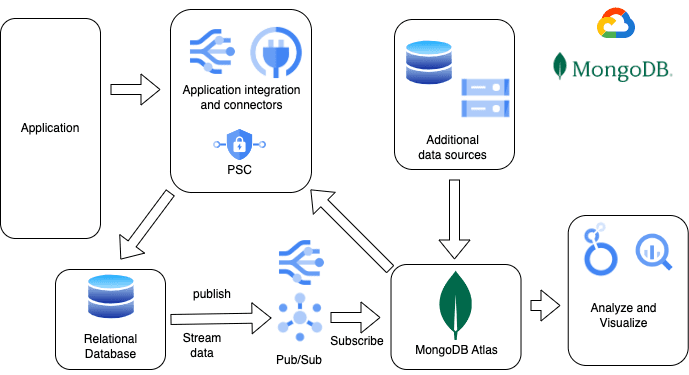Instructions for making use of the MongoDB connection inside Application Integration
In the frenetic world of digital transformation, companies try to create integrated and scalable solutions for company operations in order to remain one step ahead of their rivals and maintain a position of market leadership. Application Integration is an Integration-Platform-as-a-Service (iPaaS) solution on Google Cloud that offers a comprehensive set of core integration tools to connect and manage the multitude of applications (Google Cloud services and third-party SaaS) and data required to support various business operations.
In order for businesses to meet these demands, they frequently make use of powerful integration tools such as Application Integration. Application Integration is one example of this. Over ninety different Integration Connectors are made available to you by Application Integration so that you may construct your own integrations, such as linking to data sources like MongoDB.
MongoDB is a developer-friendly application data platform that simplifies the process of data handling by making it easier for developers to access a broad range of data using a uniform language interface. This makes it possible for MongoDB to make it easier for developers to build applications. The cloud-based version of MongoDB is known as MongoDB Atlas, and it provides users with a fully managed database along with streamlined deployment and maintenance options.
Application Integration is used by many corporate clients that utilize MongoDB Atlas as their primary operational database. This allows these customers to automate their various business processes. It makes the difficult process of integrating data and applications more simpler, and it can be used for use cases in a variety of sectors, including healthcare, retail, manufacturing, finance, telecommunications, and insurance, amongst others. In this article, we will cover an example use case involving retail operations using Application Integration and the MongoDB connector, while employing Private Service Connect (PSC) for private VPC network access.
Case in point
When it comes to storing their operational data, retail and ecommerce organizations may achieve high levels of operational agility and scalability by using MongoDB. The success of omnichannel retail experiences and the efficiency of supply chains are dependent on the availability of consistent real-time data. We’ll be concentrating on the product detail data that’s been saved in the system so that we can demonstrate the potential of integrating MongoDB and applications.
A contemporary product catalog requires a consolidated view across all data from many systems in order to function as a single point of truth if you want to provide an omnichannel application experience for your customers. It may be possible to avoid having to rebuild the current design by putting an operational data layer (ODL) in front of a historical relational layer. By using MongoDB as an ODL, you may help minimize the stress on already-existing systems, enhance availability, and cut down on the amount of time it takes for customers to get a response.
After that, you can utilize Application Integration to construct the orchestration that is provided below in order to maintain a real-time synchronization of data between MongoDB and the other systems.
The relational database and MongoDB are maintained in sync with the help of a change stream whenever there is an update to the product data that is stored in an existing system (which is a relational database). The MongoDB connection of Application Integration in the process is activated after the Pub/Sub trigger in Application Integration gets the change stream from an existing system.
The Pub/Sub trigger in Application Integration receives the change stream. It is possible to map messages coming from the Pub/Sub trigger in integration by using Data Mapper. These mapped messages may then be placed into MongoDB by utilizing the MongoDB connector.
The MongoDB connection makes it possible to do actions such as inserting, updating, and deleting document objects in the MongoDB database. It also supports MongoDB’s client-side encryption architecture, which enables users to change documents using encryption. Examples of how this feature may be used can be found on this page. Each of the procedures is presented to the user in the form of an action inside the Application Integration Connector task.
Connectivity for private services only
The MongoDB connector now supports Google Cloud’s Private Service Connect, which enables users to read and write data from MongoDB without compromising the integrity of the connection between MongoDB and Application Integration. The on-premises and private connection to MongoDB that is supported by Private Service Connect makes for a more simplified user experience. Here you will find a full walkthrough of the procedures required to configure a private endpoint for the MongoDB connection.



[…] run MongoDB Atlas. The popularity of the MongoDB Atlas on Azure pay-as-you-go self-service has made MongoDB one of our top Azure Marketplace partners in the previous six […]